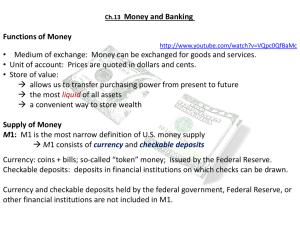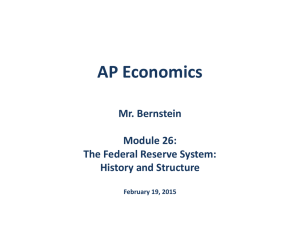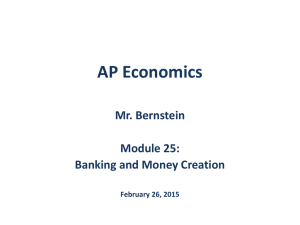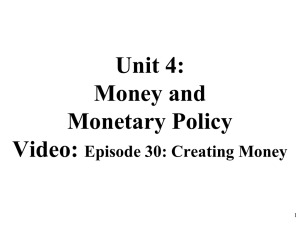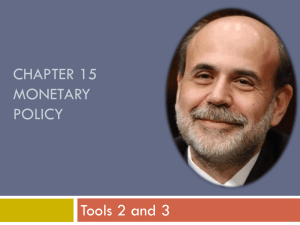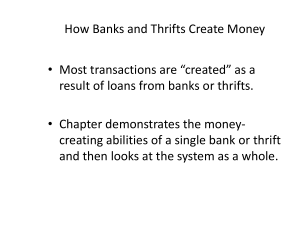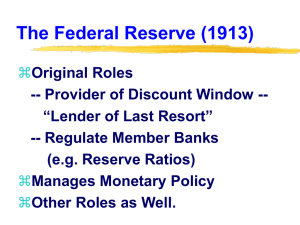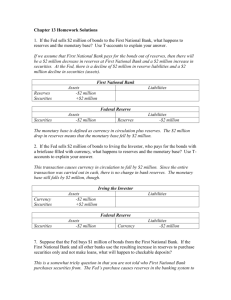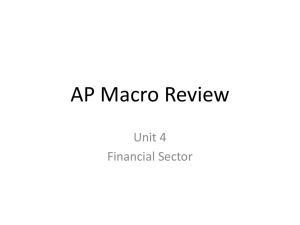The Fed*s Toolbox - High School Economics
advertisement
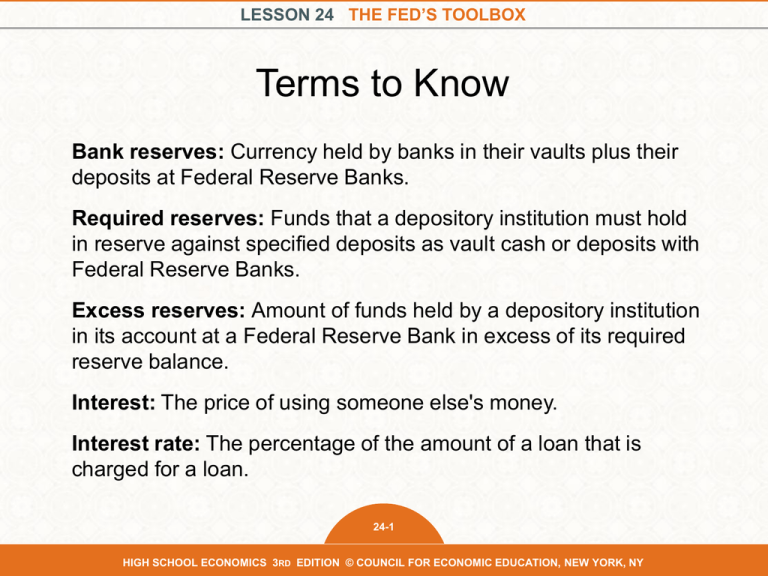
LESSON 24 THE FED’S TOOLBOX Terms to Know Bank reserves: Currency held by banks in their vaults plus their deposits at Federal Reserve Banks. Required reserves: Funds that a depository institution must hold in reserve against specified deposits as vault cash or deposits with Federal Reserve Banks. Excess reserves: Amount of funds held by a depository institution in its account at a Federal Reserve Bank in excess of its required reserve balance. Interest: The price of using someone else's money. Interest rate: The percentage of the amount of a loan that is charged for a loan. 24-1 HIGH SCHOOL ECONOMICS 3RD EDITION © COUNCIL FOR ECONOMIC EDUCATION, NEW YORK, NY LESSON 24 THE FED’S TOOLBOX Terms to Know Federal funds market: The market in which banks can borrow or lend reserves, allowing banks temporarily short of their required reserves to borrow from banks that have excess reserves. Federal funds rate: The interest rate at which a depository institution lends funds that are immediately available to another depository institution overnight. Federal Reserve System: The central bank system of the United States. 24-2 HIGH SCHOOL ECONOMICS 3RD EDITION © COUNCIL FOR ECONOMIC EDUCATION, NEW YORK, NY LESSON 24 THE FED’S TOOLBOX Terms to Know Monetary policy: The actions of a central bank to influence the cost and availability of money and credit to achieve the national economic goals. Tools that the Fed has in its toolbox to influence money supply/interest rates: • Discount rate: The interest rate charged by the Fed to banks for loans obtained through the Fed's discount window. • Open-market operations: The buying and selling of government securities through primary dealers by the Fed in order to influence the money supply. • Reserve requirements: Funds that Banks must hold in cash, either in their vaults or on deposit at a Reserve Bank. • Interest on reserves: Interest paid by Federal Reserve Banks on required and excess reserves held by banks. 24-3 HIGH SCHOOL ECONOMICS 3RD EDITION © COUNCIL FOR ECONOMIC EDUCATION, NEW YORK, NY LESSON 24 THE FED’S TOOLBOX Open Market Operations Simulation Federal Reserve (teacher) The Federal Reserve gets money—reserves of $60,000— and the Federal Reserve Portfolio Tracker. Primary Dealers (three students) Primary dealers buy and sell government securities from the Federal Reserve. Investors (six students) Each investor gets a $10,000 Government Security and an Investor Balance Sheet. Banks (six students) Each bank gets two deposit slips. Treasurer (one student) Treasurer gets the Treasurer’s Balance Sheet for the Class. 24-4 HIGH SCHOOL ECONOMICS 3RD EDITION © COUNCIL FOR ECONOMIC EDUCATION, NEW YORK, NY LESSON 24 THE FED’S TOOLBOX Investor Balance Sheet Assets (securities) Assets (deposits) Total Assets (securities + deposits) Assets (money/reserves) Liabilities (deposits) Net Assets (assets - liabilities) Initial End of Round 1 End of Round 2 Bank Balance Sheet Initial End of Round 1 End of Round 2 Federal Reserve Portfolio Tracker Government Securities Initial $0 End of Round 1 End of Round 2 24-5 HIGH SCHOOL ECONOMICS 3RD EDITION © COUNCIL FOR ECONOMIC EDUCATION, NEW YORK, NY LESSON 24 THE FED’S TOOLBOX Money Federal Reserve Primary Fed buys bonds Dealers Banks Bank reserves increase Bonds Expansionary monetary policy: Actions taken by the Federal Reserve to increase the growth of the money supply and the amount of credit available. Interest rates decrease Borrowing increases 24-6 HIGH SCHOOL ECONOMICS 3RD EDITION © COUNCIL FOR ECONOMIC EDUCATION, NEW YORK, NY LESSON 24 THE FED’S TOOLBOX Bonds Federal Reserve Fed sells bonds Primary Dealers Banks Bank reserves increase Money Contractionary monetary policy: Actions taken by the Federal Reserve to decrease the growth of the money supply and the amount of credit available. Interest rates decrease Borrowing increases 24-7 HIGH SCHOOL ECONOMICS 3RD EDITION © COUNCIL FOR ECONOMIC EDUCATION, NEW YORK, NY LESSON 24 THE FED’S TOOLBOX Terms to Know Central bank: An institution that oversees and regulates the banking system and quantity of money in the economy. Dual mandate: The Federal Reserve's responsibility to use monetary policy to promote maximum employment and price stability. • Price stability—A low and stable rate of inflation maintained over an extended period of time. The Fed has a longer-run goal of 2 percent inflation. • Maximum employment—The Fed does not have a specific unemployment target but regularly publishes a forecast for the longer-run unemployment rate. 24-8 HIGH SCHOOL ECONOMICS 3RD EDITION © COUNCIL FOR ECONOMIC EDUCATION, NEW YORK, NY

